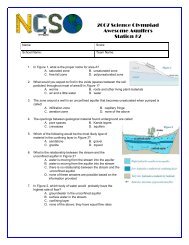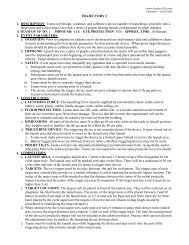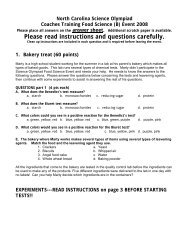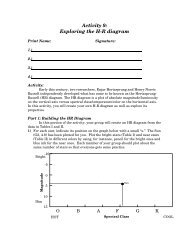2010 Coaches Institute Presentation
2010 Coaches Institute Presentation
2010 Coaches Institute Presentation
Create successful ePaper yourself
Turn your PDF publications into a flip-book with our unique Google optimized e-Paper software.
NC Science<br />
Olympiad<br />
<strong>Coaches</strong> <strong>Institute</strong><br />
<strong>2010</strong>
Storm The Castle<br />
Division B & C
Storm the Castle<br />
• Prior to the Tournament, Teams will design,<br />
construct, and calibrate a device that uses<br />
only the energy of a falling counterweight to<br />
launch a projectile as far and accurately as<br />
possible.
• Read the rules<br />
• Discuss the rules<br />
• Read the rules<br />
Rules<br />
• Have the students copy the rules<br />
• Read the rules again<br />
• Highlight the rules<br />
• Understand the rules
Rules<br />
Event Parameters<br />
• Team size, Max of two (2)<br />
• Must wear eye protection. (ANSI Z87+)<br />
• Impound event (What does this mean)<br />
• The launch device, graphs, and all materials<br />
teams will use must be impounded (checked in at<br />
the event) prior to the competition.
Design<br />
Construction<br />
• Size: everything must fit inside a cube<br />
(when in the Ready to Fire Position)<br />
• Division B – 75cm cube<br />
• Division C – 75cm cube (NC Only)
Construct<br />
• Floating Arm Trebuchet<br />
• Recently, a new type of trebuchet has been<br />
devised. This modern version of the trebuchet<br />
uses the energy more efficiently, so the range is<br />
greater compared to a hinged counterweight<br />
trebuchet. A wheel is fixed to the arm, so that it<br />
can roll horizontally during launch. The<br />
counterweight is constrained to a vertical motion.
Construct<br />
• Floating Arm Trebuchet<br />
• http://www.youtube.com/watchv=SnpYvpqnNpI
Design<br />
Construction<br />
• Triggering device is not part of the device:<br />
• It may be Battery<br />
• It may not be radio controlled<br />
• It may not pose a danger<br />
• It must extend out of the launch area
• Trigger<br />
Construction<br />
• This can be simple or complex<br />
Arrow<br />
Release<br />
Pelican<br />
Hook<br />
Panic<br />
Snap
• Trigger<br />
Construction<br />
• You can use eye hooks and a cotter pin<br />
• Use a strong cord to pull the pin
Design<br />
Construction<br />
• Construct the device to accommodate the<br />
counterweight and the projectiles.<br />
• No modification of items provided is allowed
Design<br />
Construction<br />
• The Counterweight<br />
• The counterweight will be a 1 to 3 kg mass<br />
with a hook on top.<br />
• The hook and the counterweight will fit inside a<br />
15 cm cube<br />
• If the hook is used to attach the counterweight,<br />
the eye must be 9 mm in diameter and no more<br />
than 6.5 mm thick.
Design<br />
Construction<br />
• The Projectile<br />
• Projectiles will have a mass of 20 – 60<br />
grams and will be approximately spherical<br />
with a diameter not exceeding 6 cm.
Projectiles<br />
• Racquetballs<br />
• Ping-pong balls<br />
• Practice Golf Balls
Launch<br />
• The device, without the counterweight and<br />
projectile, must not contribute energy to the<br />
launch.<br />
• Example: the launch arm must not make a<br />
launch motion when released from any position<br />
before the point where the projectile is released.
Catapult Science<br />
• Math behind the event:<br />
• www. open2.<br />
net/diyscience/mangonel/catapult_downloa<br />
d.pdf
Catapult Science<br />
• We must calculate the Force (N) exerted<br />
by the throwing arm.<br />
• To do this we need to know the velocity at take<br />
off calculated in meters per second (m/s)<br />
• We also must work out how fast the arm<br />
accelerates. Acceleration describes changes in<br />
velocity (m/s 2 ).<br />
• The force comes from the counterweight<br />
attached to the arm.
Catapult Science<br />
• If we know how long it takes to go from<br />
take off to landing we know it takes gravity<br />
X seconds to slow from take off speed to 0.<br />
• Gravity will accelerate any object at 9.8<br />
meters per second per second.<br />
• Now we want to figure the Vertical Velocity.
• Vertical Velocity<br />
Catapult Science<br />
• Vv = The final component of velocity in the<br />
vertical direction = 0<br />
• Uv=The initial component of velocity in the<br />
vertical direction= (This is what we are looking<br />
for)<br />
• Av=The component of acceleration in the verticle<br />
direction (-gravity)<br />
• T = time taken
• So our formula is:<br />
• Vv = Uv + AvT<br />
Catapult Science<br />
• We know Vv is 0, we are going to assume the<br />
time (T) is 1.6 seconds<br />
• Therefore: 0 = Uv + (9.8 X 1.6) solve this<br />
equation and we have<br />
• Uv = 15.7 meters/second This is our Vertical<br />
Velocity we will use it again later.
Catapult Science<br />
• Ok, so the projectile does not just go up and<br />
down.<br />
• We must look at Horizontal Velocity<br />
• There is a component of velocity Vx in the horizontal<br />
direction.<br />
• This is because they take off at angle theta (Θ) not<br />
vertically<br />
• Since Vy and Vx can be treated as vector quantities the<br />
velocity of take off can be calculated from trigonometry.
Catapult Science
Catapult Science<br />
• Vt = Velocity (this is what we are looking<br />
for) It will be the hypotenuse of this triangle.<br />
• Vy = Vertical Velocity (15.7 m/s)<br />
• sin = sine – ratio of the height to the<br />
hypotenuse.<br />
• Θ = theta – symbol to describe how big the<br />
angle is in degrees.
• So our formula is:<br />
• Vt = Vy /sin Θ<br />
Catapult Science<br />
• We need to know what the angle is<br />
• The distance the projectile travels depends upon<br />
the point it leaves the arm.<br />
• If the angle of trajectory is Θ to horizontal then<br />
the projectile travels 90 – Θ when being thrown.
Catapult Science<br />
• The circumference of a circle is 2pr<br />
• In our case, r is the length of the throwing arm.<br />
We will estimate 50 cm.<br />
• So if the arm traveled a full circle it would travel<br />
(2 X 22/7 X 50)cm or 314.3 cm<br />
• So 90 – Θ means our arm moves 314.3(90-<br />
Θ)/360 cm. (assume 45)<br />
• The arm must travel 39.3 cm.
Catapult Science<br />
• The load needs to leave the arm before it<br />
reaches 90 or there is no vertical velocity.<br />
(the force of the arm drops off) You<br />
probably will max out at 70.<br />
• We used 45. We will work from here.<br />
• So Velocity V is 15.7 / sin45 = 22.2 m/s
Catapult Science<br />
• We now know how much the arm accelerates with<br />
a final velocity Vf = 22.2 m/s. We will use this to<br />
calculate the forces.<br />
• V 2 = U 2 + 2as<br />
• V = final velocity (22.2)<br />
• U = initial velocity (0)<br />
• a = acceleration (what we are solving for)<br />
• s = speed assuming constant acceleration over the<br />
distance moved we calculated the distance moved as<br />
314.3 X 45 / 360 = (39.3 cm)
Catapult Science<br />
• V 2 = U 2 + 2as<br />
• 22.2 2 = 0 + 2 X a X 39.3<br />
• a = 22.2 2 / 78.6<br />
• a = 6.27 m/s 2
• To work out the forces we will use<br />
Newton’s First Law.<br />
• F = ma<br />
Catapult Science<br />
• F stands for the net force<br />
• m is the mass of the projectile<br />
• a is acceleration
• If the mass of a racquet ball is 39.7 grams<br />
• And our acceleration is 6.27 m/s 2<br />
• F = 39.7 X 6.27<br />
Catapult Science<br />
• F=.2489 Newtons (Km/s 2 )<br />
• If you use this much force and the ball<br />
stays in the air 1.6 seconds the ball should<br />
travel over 35 meters (115 feet).
• The launch area<br />
is a 2m X 2m<br />
square. The<br />
device can not be<br />
attached to the<br />
floor.<br />
Launch Area
• The target will be<br />
an open toped<br />
container with a<br />
minimum<br />
dimension of 20<br />
cm X 20 cm X 20<br />
cm.<br />
Target Area
Scoring<br />
• The winner will be the team with the highest Final<br />
Score (FS).<br />
• FS = Sum of 2 best Launch Scores (LS) + Graph<br />
Score (GS) – Penalties<br />
• Each team gets three launches.<br />
• To get the score you use the formula:<br />
• LS = (TD – A) + B<br />
• LS = Launch Score<br />
• TD = Target Distance<br />
• A = Accuracy Score<br />
• B = Bonus Score
• Launch Score (LS)<br />
Scoring<br />
• To get the launch score you use the formula:<br />
• LS = (TD – A) + B<br />
• LS = Launch Score<br />
• TD = Target Distance<br />
• A = Accuracy Score<br />
• B = Bonus Score
• Graph Score (GS)<br />
Scoring<br />
• To get the graph score (possible 12 points):<br />
Partial credit may be given.<br />
• Labeled with school and students (2)<br />
• Title of graph and X-Y axis (2)<br />
• Units and axis increments (2)<br />
• 1 point for each graph (up to 5)<br />
• 1 point for and example calculation page
• Final Score (FS).<br />
Scoring<br />
• FS = Sum of 2 best Launch Scores (LS) +<br />
Graph Score (GS) – Penalties<br />
• FS = LS1 + LS2 + GS - Penalties
Scoring<br />
• Teams will be ranked in tiers based upon;<br />
• Teams with no violations. (Tier 1)<br />
• Teams with Competition violations (Tier 2)<br />
• Teams with Competition and construction violations or<br />
missed impound. (Tier 3)<br />
• Tiebreakers are:<br />
• 1 st Best launch score.<br />
• 2 nd Second best launch score.<br />
• 3 rd Third best launch score.
Penalties<br />
• Ouch!<br />
• A 3 point penalty will be added each time any of<br />
the following occurs:<br />
• Not wearing eye protection<br />
• Is in the launch area (when a launch occurs)<br />
• Device goes through an intentional launch motion<br />
• Does not give a warning prior to launch (Fire in the<br />
Hole!!!!!)<br />
• Any part of the device is outside the launch area.
Collect Data<br />
• The purpose of data collection is to provide<br />
students with an understanding of test and result.<br />
• Determine what data you should collect<br />
• The mass of various projectiles or counterweights verses<br />
distance.<br />
• (if you use hand drawn graphs they must be on graph paper)<br />
• Two copies of each<br />
• Marked to identify the team and school
• Measure carefully<br />
Construction<br />
• Use smooth action on the moving parts.<br />
• Attach your counterweight for force<br />
securely.<br />
• Weight is not an issue.<br />
• Metal angles will work in many cases.
Construction<br />
• Make sure your boards and angles are square<br />
and tight.<br />
• Be sure the projectile holder does not restrict the<br />
release of the projectile.<br />
• Use plywood for stability<br />
• Use solid construction with screws and or nails<br />
•Hands on Review of<br />
Catapults.
Instructor<br />
• Jim Roberts<br />
• roberts@campbell.edu<br />
• Worked with Science Olympiad since 1998.













![Shock Value Practice Test[1].pdf - Science Olympiad Student Center](https://img.yumpu.com/42685889/1/190x245/shock-value-practice-test1pdf-science-olympiad-student-center.jpg?quality=85)



